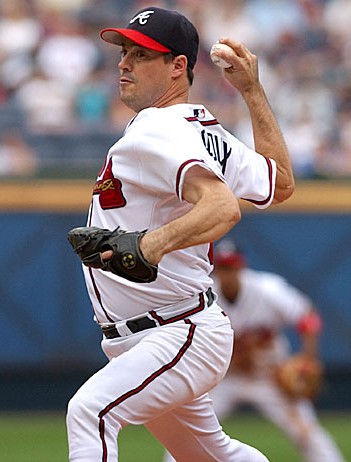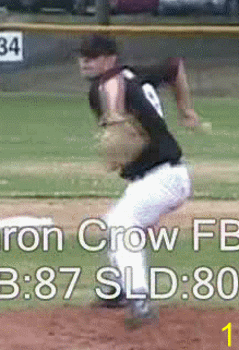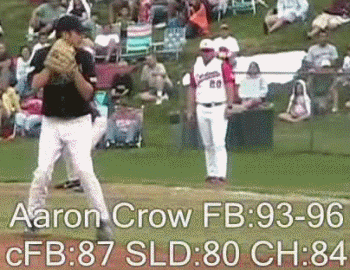Pitching Mechanics Analysis
Aaron Crow
3.29.2008
Aaron Crow is a pitcher for the University of Missouri who
has been getting a lot of attention lately due to a string of
strong performances. I recently came across a fairly glowing
analysis of Aaron Crow's pitching mechanics at
Saberscouting.com that I
strongly disagree with.
Let me explain why I think this
analysis is seriously flawed.
A Red Herring
In the analysis, when examining Aaron Crow's arm action, the
writer focuses on the wrap (or hook) in Aaron Crow's wrist and
what he thinks the consequences of that will be.
Basically, Crow is firing the muscles from his elbow to his
wrist when he’s not supposed to be, to create this cocking of
the wrist. That might not sound like a big deal, but using more
muscles than you need to not only outputs less power (relaxed
muscles more powerful than firing ones, hence preferred
effortless mechanics) but is stressing that area of the arm. It
stresses the arm because you want as little wasted motion and
muscle use as possible, and this makes an unnatural motion have
more effort in it—like pitchers aren’t injured enough. So what are the side effects of this type of move? Elbow
soreness and eventually, most likely, Tommy John surgery.
While the above sounds good, the truth is that it makes no
sense anatomically or physiologically. A hooked wrist can
certainly cause control problems due to the tension it
creates in the wrist, but it is unlikely to cause elbow problems.
First, a pitcher's primary source of power is the
muscles of their core, not their arm. While tensing up the
muscles of the forearm might impact a pitcher's control, it will
not have an appreciable impact on a pitcher's velocity because
those muscles don't create much, if any, velocity.
Second, as
the name implies, the Ulnar Collateral Ligament (or UCL) is a
ligament, not a muscle. When you hook your wrist, it has little
impact on the structure of the elbow, and no impact on the UCL.
What matters when it comes to the health of the UCL is the torque that is
applied to the elbow as the shoulders rotate and the Pitching
Arm Side (PAS) forearm is still vertical.
The Real Problem
The person who wrote the analysis of Aaron Crow for
Saberscouting.com apparently belongs to a school of thought, led
by Paul Nyman of Setpro.com, that extols the virtues of arm
action and scapular loading.
As for the rest of the arm action: Well, it’s just great.
Aggressive, no pauses (just slows down a bit with the wrap),
elbow picks up the ball, high torque, good scap load, all the
elements are there.
So, the conventional wisdom is that Crow has an okay
delivery, clean arm action. I would say great delivery, okay arm
action. It’s more a semantic difference, but I wanted to
clarify. What that means 20-80 scale with is that he’s great arm
action with a red flag, still a little better than a totally
clean arm with no aggression, as he may never get hurt and it
works for him. Call it 55.
The problem is that they don't understand that, as I point
out in my article on
Scapular
Loading, there appears to be a safe way to scap load and an
unsafe way to scap load. As I explain in my article on
scapular loading, the safe
way to scap load is to follow the example of Greg Maddux and keep the elbows below the level of
the shoulders like this.

Greg Maddux
Aaron Crow's arm action is quite different than Greg
Maddux's. As the author explains, Aaron Crow breaks his hands
with his elbows and lets his elbows pick up the ball. You can
see this in the clip below.

Aaron Crow
Notice how high Aaron Crow's PAS elbow gets in Frame 1 and
then stays in Frame 2 and Frame 3 of the clip above.

Aaron Crow
You can see the same thing in the clip above of Aaron Crow.
Notice how high Aaron Crow's PAS elbow gets in Frames 17 through
20. His PAS arm passes through a classic
Inverted
W position.
Why is this a problem?
First, it increases the strain on Aaron Crow's shoulder
because his PAS upper arm is rapidly externally rotating while
his PAS elbow is still quite high. This can lead to an
impingement injury. Second, it affects Aaron Crow's
Timing and
makes his arm late. This increases the load on both his shoulder
and his elbow.
All of this makes Aaron Crow a risky proposition for
the team that picks him in the 2008 draft.
Update 6.5.2008
I'm listening to the MLB draft and heard two things mentioned
about Aaron Crow.
First, an analyst just came on and talked about how
scouts are focused on the hook in Aaron Crow's
wrist as his major mechanical red flag. I believe that people's focus on Aaron
Crow's hooked wrist reflects an unfortunately common lack of understanding of pitching mechanics.
Aaron Crow's main problem is his significant
Inverted
W, and the negative impact it has on his
Timing, not the hook in his wrist.
Second, I just heard it mentioned that Aaron Crow has a
good slider. As you know, I hate the slider and think it is very
bad for the elbow due to the high-speed supination. Combine that
with his Inverted W and I wonder how long his elbow (and
ultimately his shoulder) will hold up.
|